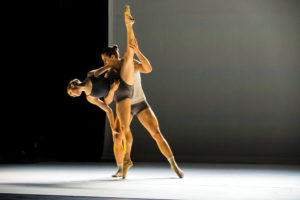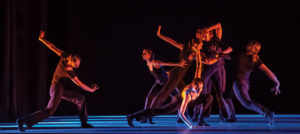Opening New Doors Together: Wen Wei Wang and Ballet Edmonton - Vancouver Ballet Society
- Home
- Features 2015 - 2019
- Opening New Doors Together: Wen Wei Wang and Ballet Edmonton

By Kate Stashko
On the September 2018 day that Wen Wei Wang arrived in Edmonton to start his position as artistic director of Ballet Edmonton it was … snowing. Although not typical weather for the northern Canadian city at that time of year, it was unnerving for Wang, who is more used to the rainy climate of Vancouver, where he has run his own contemporary dance company for about 15 years.
However, after a few weeks, Wang said he was feeling more comfortable in his new environment and looking forward to getting to know the community. He hasn’t had much time for networking and socializing so far though; he hit the ground running with his two new creations, both for the full company of eight, with only six weeks of rehearsals to create them.
The pieces, which premiered in November, have a more contemporary feel than many of the works we have seen Ballet Edmonton perform in recent years, including intricate floorwork, sliding and inventive partnering.
The show took place at the company’s new home at the Triffo Theatre in Allard Hall at MacEwan University. The 415-seat theatre is the perfect-sized house for this small group, and the design is stunning, with a dramatic curved entrance hallway and three levels of seating, giving it a formal auditorium feel despite its smaller capacity.
It is definitely fair to say that Ballet Edmonton is opening a new chapter in its story as a small to mid-sized contemporary ballet company based in the Canadian Prairies. In addition to the new performance venue, the company has hired new dancers and changed its name from the rather quaint Citie Ballet to one that “proudly defines the company’s place in the Canadian arts ecosystem,” as general manager Sheri Somerville puts it.

Photo: Emilie Iggiotti
The name also defines the city’s place: over the last 10 years, Edmonton has grown. There has been a strong theatre community, and the contemporary dance scene is coming into its own, after suffering a setback when the MacEwan University dance program closed in 2008. Small-scale companies such as Ballet Edmonton are flourishing and transforming along with the city.
The company has undergone a dramatic evolution since its founding in 1998 by William Thompson, once a dancer with Les Grands Ballets Canadiens and former artistic director of Colorado Ballet. At that time, Citie Ballet was a vehicle to offer Edmonton-area dancers professional-level training and performance experience. Dancers were not paid, but gained valuable experience and many went on to have professional careers elsewhere.
Before 1990, Alberta Ballet had been based in Edmonton, but when it shifted its headquarters to Calgary, the city was without a ballet company (although Alberta Ballet always tours its shows to Edmonton and recently established an Edmonton branch of its school). This prompted Citie Ballet board member Lynn Mandel, a major arts supporter and former dancer with Alberta Ballet, to encourage the company to transition to professional status. It finally achieved this in 2012, meaning, especially, that dancers were paid. Since then, the company has been able to attract more experienced artists, both to perform with and choreograph on them.
The current transformation, however, is perhaps the most substantial the company has seen, led by Wang, an exciting contemporary choreographer who will guide Ballet Edmonton through a transition in both aesthetics and structure.
No small feat. Wang admits that the first few days in Edmonton were challenging, both for him and for the dancers, who all have strong classical ballet training from prestigious programs at the Royal Winnipeg Ballet, the National Ballet of Canada and the Paris Opera, but less experience in contemporary dance. His two new works involved an intense introduction to Wang’s aesthetic, which involves fluid use of the torso, sliding, rolling and moving in and out of the floor smoothly. The results, however, were encouraging: X-Body is an aggressive, demanding work performed on pointe that showcases the technical capabilities of the dancers. By contrast, Last Words, a more lyrical work on themes of loss and grief, was performed in soft shoes, set to music by the Peter Gregson Quartet.

Photo: Steven Lemay
Wang says the dancers — some of whom come from as far away as Jiangmen, China, and Mococa, Brazil, with two home-grown Albertans — were understandably nervous about getting to know their new artistic director. It was about building trust in both directions, and Wang has great confidence in his young collaborators. He describes them as open-minded, explaining that if the dancers want to explore a wider range of possibilities within ballet, they can open that door together.
Wang takes over the directorship from Jorden Morris, making him the fourth person to tackle the job over 20 years. His plans include expanding the number of dancers (there is an ongoing call for new dancers) and continuing the company’s tradition of commissioning work from Canadian choreographers. Wang has already programmed a double bill by Vancouver artists Joshua Beamish and Rachel Meyer to premiere in March. These commissions benefit the company by broadening the dancers’ skills as interpreters and expanding its repertoire, while offering opportunities to Canadian choreographic talent.
“We have great artists here,” Wang says, “and they need work.” He is excited about the choreographers the company will be commissioning in the coming seasons, although he is keeping this information close for the moment.
Wang feels that his role will involve elevating the calibre of the dancers and the work being created by Ballet Edmonton, transforming its reputation and place within Canadian dance. He is already teaching company classes in both ballet and contemporary, broadening the dancers’ skillsets and helping them prepare to perform his work.
He also has a vision of Ballet Edmonton as a more integrated player in the Edmonton arts scene. He hopes to foster more connections and collaborations with local musicians, and the company has opened its classes to the public for the first time in its history. Wang has also begun inviting artists to view run-throughs in the company’s spacious studio at the Ruth Carse Centre for Dance. “I knew that if I came here, I wanted to build a totally new, contemporary ballet company.” And he seems to be doing exactly that.
Taking leadership of a regional ballet company as it transitions to a new level is a huge commitment. The challenge is amplified by the fact that Wang continues to manage and work with his own company, Wen Wei Dance, in Vancouver during breaks in his contract. In addition to the creative and administrative workload of maintaining both companies, there will be the potential fatigue from several trips back and forth flying between Vancouver and Edmonton. What motivated this change of pace?
It was, at least in part, due to an ongoing theme in Wang’s life: facing newness with curiosity and a sense of adventure. Born in Xi’an, China, Wang studied choreography at the People’s Liberation Army Academy of Art in China as a young dancer. In 1991, he came to Canada, dancing for several years with Ballet BC before founding Wen Wei Dance in 2003. The company was a vehicle for him to begin choreographing his own work. Since then, he has received commissions from Alberta Ballet, BJM Danse and, in the United States, Northwest Dance Projects, among others.
These commissions involve coming into a company, choreographing a work quickly and then leaving, often not seeing the dancers again for many years, if at all. So when an opportunity arose to work with dancers on a more consistent basis, creating contemporary ballet work, Wang grabbed it. The solid classical background of Ballet Edmonton’s dancers provides a specific skillset that allows Wang to choreograph work on pointe, incorporating classical vocabulary and intricate partnering. “I want to do something interesting and see how much I can stretch myself.”

Photo: Nanc Price
While Wang, who is in his 50s, has an opportunity at Ballet Edmonton to create work in a more consistent and stable environment, through his nationally recognized name the company gets a boost to its reputation and builds its presence on a national level. However, leading a company as it navigates a major transition is a huge amount of work, and Ballet Edmonton is charting this course on limited resources. Wang is committed to helping the company reinvent itself; like most people in the arts, he’s not in it for the money. But, of course, it’s not really about the money.
He speaks about his late mentor Grant Strate — a founding member of the National Ballet of Canada and later a much-loved mover-and-shaker in Canadian dance — who passed away in 2015. Strate would remind him not to think too much about making money, but to remember his love for the art form. “I feel like Grant is always there pushing me … saying, ‘Go, you will do it, you will be fine.’ I think he would be proud of me.”
Wang speaks about how we can move past grief by embracing community, creating a sense of openness and co-operation. His goals for the company are based in this ethos of connection. Already many independent dancers are attending company class, creating a broader sense of relationship with Ballet Edmonton and generating some excitement around the company’s shows.
In fact, there was a real buzz in the air leading up to the November premiere. Among the people I spoke with, there was an agreement that Ballet Edmonton is on an exciting new track. The dancers looked fantastic — Wang has capitalized on their skills and strengths — and the company has already grown in depth and maturity since last season. Houses were nearly sold out throughout the run, and the audience provided a supportive and enthusiastic reception to this season opener for a transformed Ballet Edmonton.

Photo: Nanc Price
